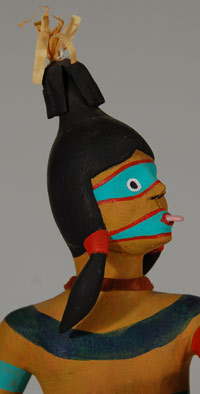Hopi Kaisale Clown [SOLD]
+ Add to my watchlist Forward to Friend
- Category: Traditional
- Origin: Hopi Pueblo, Hopituh Shi-nu-mu
- Medium: wood, paint, cornhusk, yarn
- Size: 14” tall
- Item # C3383U SOLD
 Koosa is the umbrella term for the clowns of the Tewa and they may be subdivided into the Kwirena, the winter clowns, and the Koshari, the summer clowns. At Hopi, the Tewa Kwirena is known as the Kaisale. The Kaisale are most often associated with the moon and cold, or winter, according to Barton Wright, noted Katsina authority. He states that the single horn that adorns the top of the head is frequently referred to as ice, an icicle, or an ice mother. At the tip of the horn are long shreds of corn husk. The body is painted in colorful horizontal stripes.
Koosa is the umbrella term for the clowns of the Tewa and they may be subdivided into the Kwirena, the winter clowns, and the Koshari, the summer clowns. At Hopi, the Tewa Kwirena is known as the Kaisale. The Kaisale are most often associated with the moon and cold, or winter, according to Barton Wright, noted Katsina authority. He states that the single horn that adorns the top of the head is frequently referred to as ice, an icicle, or an ice mother. At the tip of the horn are long shreds of corn husk. The body is painted in colorful horizontal stripes.
Although considered to be clowns, that function is not the most important as it is with the Koshari. The Kaisale are concerned with sprouting or germination of corn. Interestingly, the name Kaisale is an alternate name for the Koshari at Zuni Pueblo.
This carving by Malcolm Youvella was very well executed in body style and proportion. He has his tongue stuck out and has only a single moccasin, indications that he is clowning around in this presentation.
Condition: original condition
Provenance: from the estate of Tom Mittler, a former resident of Michigan and Santa Fe who purchased it from Kachina House in Santa Fe in 1985
Recommended Reading: Hopi Katsina: 1,600 Artist Biographies by Gregory Schaaf
- Category: Traditional
- Origin: Hopi Pueblo, Hopituh Shi-nu-mu
- Medium: wood, paint, cornhusk, yarn
- Size: 14” tall
- Item # C3383U SOLD



